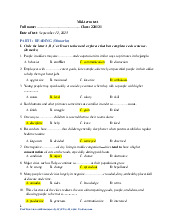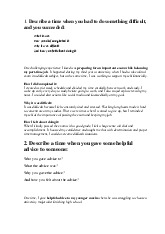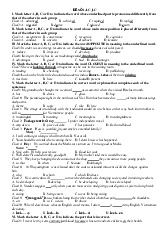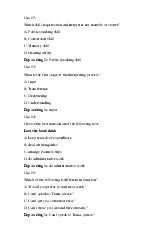





Preview text:
MCQs from Research Methodology 1.
is the first step in the research process. A. Collecting data
B. Formulating a research question C. Analyzing data D. Drawing conclusion
2. Which of the following is an example of qualitative research methods? A. Survey B. Case Study C. Experiment D. Meta-analysis
3. What is a hypothesis in research?
A. A conclusion drawn from data analysis
B. A summary of research findings
C. A measurement of data accuracy
D. A statement of predicted relationship between variables
4. What is the purpose of a literature review in research?
A. To identify the research gaps
B. To summarize research findings C. To collect primary data D. To analyze data
5. What is a dependent variable in research?
A. The variable that is manipulated by the researcher
B. The variable that remains constant throughout the research
C. The variable that is measured and observed
D. The variable that is not relevant to the research question
6. What is the purpose of a research proposal?
A. To present research findings
B. To provide a rationale for the study C. To establish causality
D. To guide the data collection process 7. What is a research design? A. A plan for data analysis
B. A method for data collection C. A statistical technique
D. A framework for conducting research
8. What is the purpose of statistical analysis in research?
A. To summarize research findings B. To collect primary data
C. To draw conclusion from data
D. To develop research hypotheses
9. What is the appropriate statistical analysis for comparing means between two groups? 1 A. Chi-squared test
B. Analysis of variance (ANOVA) C. Regression analysis D. T-test
10. What is the purpose of a control group in an experiment?
A. To provide a baseline for comparison
B. To receive the experimental treatment
C. To control for confounding variables
D. To ensure internal validity
11. Which of the following is an example of a primary source of data? A. Research article B. Textbook C. Meta analysis
D. Interview transcript 12.
is the characteristics of qualitative research. A. Large sample size
B. Standardize data collection methods
C. Emphasis on context and social interactions
D. Objectives and detached perspective 13.
is NOT a common data collection method in qualitative research. A. Participant observation
B. Structured interviews C. Content Analysis D. Focus Groups 14.
is the primary focus of qualitative research. A. Causality
B. Understanding the meanings and interpretations of individuals C. Hypothesis testing D. Statistical analysis
15. In qualitative research, data collection methods typically include A. Structured questionnaires B. Experiments C. Surveys
D. Interviews and Observations
16. Which of the following is an example of a qualitative research question?
A. What is the prevalence of depression in college students?
B. How does gender influence job satisfaction ?
C. What is the relationship between income and happiness?
D. What are the factors that contribute to successful weight loss?
17. Which of the following research methods is primarily associated with qualitative research? A. Experimental research B. Longitudinal research C. Phenomenology 2 D. Correlation research 18.
is an example of a quantitative research method. A. Case study B. Ethnography C. Correlational Study D. Phenomenological study 19.
is the main purpose of a research hypothesis.
A. To provide a clear research direction B. To analyze data C. To establish causality
D. To summarize research findings
20. Which of the following is NOT a characteristic of a good research question? A. Clear and Focused B. Relevant and significant C. Testable and measurable D. Broad and ambiguous
21. What is a random sample in research?
A. A sample that is selected by chance
B. A sample that is selected based on specific criteria
C. A sample that is selected from population in a systematic way
D. A sample that is selected based on convenience
22. What is a case study in research?
A. A survey of a large population
B. An in-depth investigation of a single individual or group
C. An experimental design that tests a hypothesis
D. An analysis of existing statistical data 23. is a research population.
A. The group of people who participate in the study
B. The larger group from which the participants are selected
C. The variables being studied
D. THe data collected in the study
24. Which of the following is a measure of central tendency in statistics? A. Standard Deviation B. Correlation Coefficient C. Mean D. Chi-square test 25.
is a non-experimental research design.
A. Randomized controlled trial B. Quasi-experimental design C. Case Study D. Cross-sectional study
26. What is the appropriate statistical test to test the association between two
categorical variables in a research study? A. T-test 3 B. ANOVA C. Regression Analysis D. Chi-square test
27. Which statistical test is appropriate to test the difference between proportions of two groups? A. T-tests B. ANOVA C. Chi-square test D. Z-test
28. Which of the following statistical tests is appropriate to test the difference between medians of two groups? A. T-test B. ANOVA
C. Wilcoxon rank-sum test D. Regression analysis
29. Which of the following statistical tests is appropriate to test the difference between means of two related samples? A. T-test B. ANOVA C. Chi-square test D. Paired-sample test
30. Which of the following statistical tests is appropriate to test the relationship
between two continuous variables while controlling other variables? A. T-test B. ANOVA C. Chi-square test D. Regression Analysis
31. What is the main purpose of a pilot study in research? A. To gather primary data
B. To establish the sample size
C. To test the research hypothesis
D. To refine the research methodology 32.
is a non-probability sampling technique.
A. Convenience Sampling B. Stratified Sampling C. Cluster Sampling D. Simple Random Sampling
33. What is the primary purpose of inferential statistics in research?
A. To summarize and describe data
B. To explore relationships between variables
C. To interpret qualitative data
D. To test hypotheses and make inferences about a population 34.
is NOT a type of research data. A. Primary data 4 B. Secondary data C. Tertiary data D. Meta data
35. What is a literature review? A. A summary of book
B. A summary of research study
C. A summary of the literature on a particular topic D. A summary of a movie
36. What is the first step in conducting a literature review?
A. Identify the research question
B. Identify the study population
C. Identify the research hypothesis
D. Identify the research methodology
37. What is the purpose of a conceptual framework in research?
A. To provide a summary of the main concepts related to the research topic
B. To establish the theoretical foundation for the research study
C. To outline the research design and methods
D. To report the findings of the research study 38.
is NOT a step in the research process. A. Literature review B. Data analysis C. Research question D. Data collection
39. Which of the following is NOT a criterion for establishing causality in research? A. Temporal order B. Covariation C. Association
D. Control of confounding variables
40. What is a research instrument? A. The research question B. The research design
C. The data collection method D. The data analysis plan 41. is a data analysis plan.
A. A plan for collecting data in as research study
B. A plan for analyzing data collected in a research study
C. A plan for reporting research findings
D. A plan for selecting research participants
42. Which of the following is an example of qualitative descriptive data?
A. Age of participants in a research study
B. Gender of participants in a research study
C. Scores on a likert scale in a questionnaire
D. Responses to open-ended questions in a survey
43. Which of the following is a measure of central tendency? 5 A. Standard Deviation B. Variance C. Median D. Range
44. What is the mode in descriptive data analysis?
A. The value that appears most frequently in a dataset B. The average of a dataset
C. The middle value of a dataset
D. The difference between the highest and lowest values in a dataset 45.
, is NOT a characteristic of fundamental research.
A. It is exploratory in nature.
B. It is aimed at developing new theories
C. It is focused on solving practical problems
D. It is conducted without a specific application
46. Which of the following is a type of research bias? A. Descriptive bias B. Sampling bias C. Causal bias D. Inferential bias
47. What is recall bias in data collection?
A. The tendency of participants to provide socially desirable responses
B. The systematic error in measurement instruments
C. The distortion of memory in reporting past events
D. The influence of the researcher’s expectations on data collection
48. How can researcher bias be minimized in data collection?
A. Using random sampling techniques
B. Double-blind data collection
C. Using multiple data collection methods
D. Ensuring strict adherence to research protocols
49. What is bias in research methodology?
A. A measure of central tendency B. A measure of variability
C. A systematic error in data collection
D. A random error in data collection
50. How can researchers minimize bias in data collection?
A. By using a small sample size
B. By using biased data collection instruments
C. By using non-random sampling techniques
D. By using appropriate data collection and analysis methods 6
Document Outline
- MCQs from Research Methodology
- B. Formulating a research question
- B. Case Study
- D. A statement of predicted relationship between variables
- A. To identify the research gaps
- C. The variable that is measured and observed
- B. To provide a rationale for the study
- D. A framework for conducting research
- C. To draw conclusion from data
- D. T-test
- A. To provide a baseline for comparison
- D. Interview transcript
- C. Emphasis on context and social interactions
- B. Structured interviews
- B. Understanding the meanings and interpretations of individuals
- D. Interviews and Observations
- B. How does gender influence job satisfaction ?
- C. Phenomenology
- C. Correlational Study
- A. To provide a clear research direction
- D. Broad and ambiguous
- A. A sample that is selected by chance
- B. An in-depth investigation of a single individual or group
- B. The larger group from which the participants are selected
- C. Mean
- C. Case Study
- D. Chi-square test
- D. Z-test
- C. Wilcoxon rank-sum test
- D. Paired-sample test
- D. Regression Analysis
- D. To refine the research methodology
- A. Convenience Sampling
- D. To test hypotheses and make inferences about a population
- C. Tertiary data
- C. A summary of the literature on a particular topic
- A. Identify the research question
- B. To establish the theoretical foundation for the research study
- C. Research question
- C. Association
- C. The data collection method
- B. A plan for analyzing data collected in a research study
- D. Responses to open-ended questions in a survey
- C. Median
- A. The value that appears most frequently in a dataset
- C. It is focused on solving practical problems
- B. Sampling bias
- C. The distortion of memory in reporting past events
- B. Double-blind data collection
- C. A systematic error in data collection
- D. By using appropriate data collection and analysis methods



